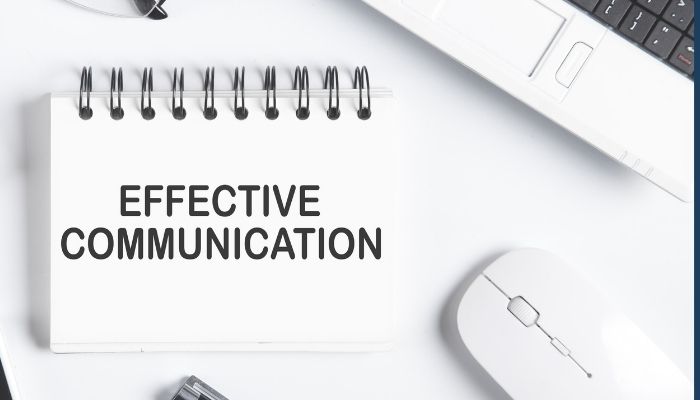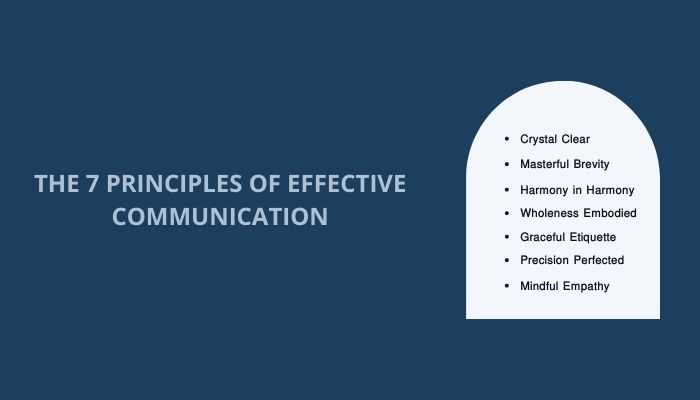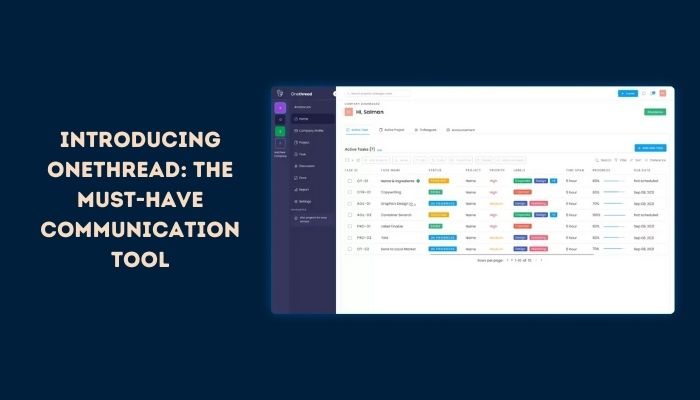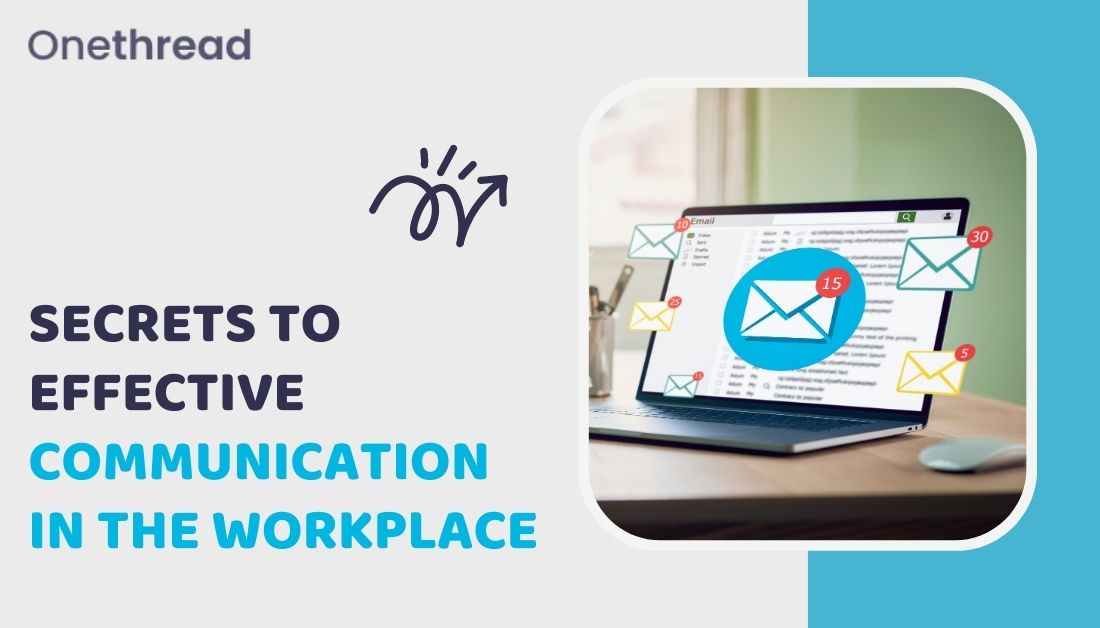Do you ever feel like you’re speaking a different language than your coworkers? Or maybe it seems like you’re always missing the memo on important information. Poor communication in the workplace can lead to frustration, misunderstandings, and even conflict. It can make you feel like you’re on a sinking ship, desperately trying to patch up the holes as fast as they appear.
So, what’s the price of poor communication in the workplace? How about a staggering $62.4 million per year for large organizations? That’s the average cost according to the Society for Human Resource Management. And that’s not all – a survey by ClearCompany found that 86% of workplace failures can be attributed to ineffective communication.
But fear not! Effective communication is not a lost art. In fact, with a few simple tips and tricks, you can become a master communicator in no time. That’s why we’ve compiled a list of 21 secrets to effective communication in the workplace.
These tried-and-true techniques will help you communicate more clearly, listen more actively, and build stronger relationships with your coworkers.
From the importance of body language to the power of asking questions, these strategies will revolutionize the way you communicate at work. You’ll learn how to give and receive feedback, how to navigate difficult conversations, and how to resolve conflicts with ease. Plus, you’ll discover how to create a culture of open communication in your workplace that fosters collaboration, trust, and success.
So, what are you waiting for? Say goodbye to miscommunications and hello to effective communication. With these 21 secrets, you’ll be on your way to becoming a communication pro in no time.
What does Effective Communication at the workplace actually mean?
At its core, effective communication is the ability to convey ideas, thoughts, and information clearly and concisely, while also being able to listen actively and understand the perspectives of others.

In a workplace setting, effective communication means that everyone is on the same page and working towards a common goal. It allows employees to understand their responsibilities, expectations, and objectives, which helps them perform their jobs more efficiently. Effective communication also helps to foster a positive work environment, where employees feel valued, respected, and heard.
However, effective communication is not just about what you say, but also how you say it. Nonverbal cues such as body language, tone of voice, and facial expressions can also impact how your message is received. That’s why it’s important to be mindful of your communication style and to adjust it as needed to fit the situation and the audience.
So, effective communication at the workplace is all about clear, concise, and respectful communication. By cultivating a culture of open communication and actively practicing good communication habits, you can improve collaboration, productivity, and the overall success of your organization.
Unveiling 21 Secrets to Effective Communication in the Workplace

1. Engage in Active Listening
Active listening is a fundamental skill that promotes effective communication. It involves fully engaging with the speaker and demonstrating genuine interest in their message. To actively listen, you must resist the urge to interrupt and focus on understanding the speaker’s perspective.
- Avoid interrupting and give the speaker your full attention.
- Show interest through non-verbal cues like nodding and maintaining eye contact.
- Reflect on what the speaker is saying before responding.
2. Use a Communication/ Project Management Tool
Unleash the power of communication tools in the workplace and watch productivity soar! These digital wonders are the secret sauce to effective communication. With instant access to information and real-time collaboration, you’ll witness seamless teamwork and projects taking off like rockets.
Say goodbye to email chains and hello to streamlined document sharing, ensuring everyone stays on the same page and nothing gets lost in the shuffle. But wait, there’s more! These tools aren’t just about work, they’re about connection. They create inclusive spaces for brainstorming, feedback, and celebrating wins, fostering a sense of belonging and boosting job satisfaction.
From virtual meetings to project management platforms, communication tools like Onethread are your trusty sidekicks on the journey to workplace success.
3. Be Clear and Concise:
Clear and concise communication helps eliminate misunderstandings and promotes effective information transfer. When delivering your message, use language that is easy to understand and free from unnecessary complexity. Avoid jargon or technical terms that might confuse your audience. Take the time to organize your thoughts before communicating to ensure your message is logical and coherent, enabling others to grasp your intended meaning easily.
Still confused? Remember these short tips on being clear and concise:
- Remove unnecessary information.
- Use clear and straightforward language.
- Structure your message logically.
- Focus on what’s most important.
- Use precise and impactful language.
4. Practice Non-Verbal Communication:
Non-verbal communication plays a significant role in conveying messages accurately. Pay attention to the speaker’s body language and facial expressions, as they can provide insights into their emotions and attitudes. Likewise, ensure your non-verbal cues align with your spoken words to reinforce your message’s sincerity and authenticity.
Additionally, be mindful of your tone of voice, as it can heavily influence how your message is interpreted by others.
5. Be Empathetic:
Empathy is the ability to understand and share the feelings of others. It is an essential aspect of effective communication, as it allows you to connect on a deeper level and build rapport. Practice putting yourself in others’ shoes to gain insight into their perspective and emotions.
Show empathy by acknowledging their feelings and offering support when appropriate. Responding with empathy and understanding creates a safe and supportive environment, enabling open and honest communication.
6. Show Respect:
Respect is a fundamental aspect of any successful workplace communication. Treat all individuals with respect and professionalism, irrespective of their position or background. Embrace diverse opinions and encourage open dialogue, allowing for a variety of perspectives to be heard and considered.
By fostering a culture of mutual respect, you create an environment where people feel valued and safe to express their thoughts and ideas.
7. Embrace Open-Mindedness:
Open-mindedness is crucial for effective communication and promotes a culture of creativity and collaboration. Be willing to listen to and consider new ideas and feedback from others. Encourage a safe space where individuals feel comfortable sharing their thoughts and suggestions without the fear of judgment.
Embracing diverse perspectives fosters innovation, enhances problem-solving, and encourages teamwork within the workplace. Here are 5 quick tips on how to be more open-minded-
- Value different perspectives.
- Hear others without judgment.
- Be open to learning and growth.
- Understand others’ viewpoints and feelings.
- Encourage constructive discussions.
8. Use Feedback Constructively:
Constructive feedback is a valuable tool for improving communication and fostering personal and professional growth. When providing feedback, focus on specific behaviors or actions rather than personal attributes. Be specific and offer suggestions for improvement, emphasizing a supportive and developmental approach.
Similarly, be open to receiving feedback yourself and view it as an opportunity for self-reflection and continuous improvement.
9. Be Adaptive:
Adaptability is essential for effective workplace communication. People have different communication styles and preferences, so it’s important to adjust your approach accordingly. Recognize that not everyone communicates or receives information in the same way.
Be flexible and willing to adapt your communication style to enhance understanding and establish effective connections with others.
10. Set Clear Objectives:
Clear objectives provide direction and purpose for effective workplace communication. Before initiating any communication, take the time to clearly define your objectives. This will help you craft a message that aligns with your intended outcomes.
Throughout the communication process, stay focused on your objectives, ensuring that your message remains relevant and facilitates the desired results.
11. Make the Best Use of Your Time
Timeliness is key to effective workplace communication. When sharing information, especially if it is time-sensitive or critical for decision-making, ensure you deliver it promptly. Avoid unnecessary delays that can impede productivity or result in misunderstandings.
Additionally, demonstrate respect for others’ time by being punctual for meetings and honoring deadlines. Nowadays, it can be really difficult to be punctual in commitments if you are juggling a lot of things at the same time. You can use tools like Onethread to manage your schedule, communicate and collaborate with your team and keep everything organized so that you never miss anything.
12. Use Visual Aids:
Visual aids can greatly enhance the effectiveness of your communication by making complex information more accessible and engaging. Utilize charts, graphs, or presentations to present data or concepts visually. Visuals simplify information, making it easier for others to understand and remember.
Choose appropriate visuals that effectively support and complement your message, ensuring they are clear, concise, and visually appealing. Make appropriate and creative use of the visual aids suggested below.
- Charts and Graphs
- Infographics
- Presentations
- Flowcharts and Diagrams
- Videos or Animations
- Mind Maps
- Timelines
- Illustrations
13. Follow-Up Reliably:
Following up on conversations, meetings, or requests is crucial to maintain clarity, accountability, and effective communication. It demonstrates your commitment and reliability while reducing the chances of miscommunication or missed deadlines.
After important discussions, provide written follow-up communication summarizing the key points, action items, and agreed-upon deadlines. This helps ensure everyone is on the same page and clearly understands their responsibilities.
14. Choose the Right Medium:
Choosing a suitable communication medium is crucial for effective workplace communication. Evaluate each situation and consider the strengths and weaknesses of various communication methods. Determine whether email, phone calls, video conferences, or face-to-face discussions would be most appropriate.
Factors such as urgency, complexity, and the need for immediate feedback should guide your decision to ensure the message is effectively conveyed. With numerous communication platforms right at our fingertips, it might be a hassle to go through every one of your communication channels and keep everything tidy.
Here’s where Onethread comes in with all its communication features that help you organize your team communication effectively.
15. Resolve Conflict Constructively
Conflicts or disagreements are inevitable in any workplace. Developing strong conflict resolution skills is essential to address such situations constructively. Seek common ground and aim for win-win solutions that satisfy the needs of all parties involved.
- Listen actively.
- Find common ground.
- Communicate openly.
- Focus on the issue.
- Collaborate on solutions.
- Compromise when needed.
16. Avoid Assumptions:
Assumptions can lead to misunderstandings and hinder effective communication. Avoid jumping to conclusions or assuming you understand others’ thoughts or intentions. Instead, seek clarification by asking questions and actively listening to gain a comprehensive understanding.
Consider different perspectives before forming conclusions, as this promotes open dialogue and prevents misinterpretation.
17. Positive Language:
Positive language contributes to a harmonious and motivating work environment. Use words that promote collaboration, teamwork, and productivity. Frame your messages in a way that inspires and motivates others to excel.
Choose your words carefully to ensure your message conveys positivity, support, and a constructive attitude.
18. Mindfully Time Your Communication
The timing of your communication can significantly impact its effectiveness. Avoid discussing sensitive or complex topics when others are busy, stressed, or distracted. Instead, choose an appropriate time when everyone involved can focus and engage effectively.
Being mindful of timing ensures that your message receives the attention it deserves and facilitates a more productive conversation.
19. Foster Cultural Sensitivity:
In today’s diverse workplaces, cultural sensitivity is crucial for effective communication. Be mindful of cultural differences and adapt your communication style to ensure inclusivity. Respect and embrace the diversity of your colleagues’ backgrounds, perspectives, and communication preferences.
Strive to bridge any cultural gaps that may arise through open-mindedness, understanding, and a genuine commitment to fostering an inclusive work environment.
20. Uphold Confidentiality:
Confidentiality is essential for building trust and maintaining solid relationships within the workplace. Respect the privacy of sensitive information shared with you by colleagues or superiors.
Keep private conversations confidential and disclose information only to those who need to know. Follow appropriate protocols and guidelines to uphold confidentiality, fostering an environment of trust and respect.
21. Commit to Continuous Learning:
Effective communication is a skill that can always be improved. Strive for continuous learning and development in your communication abilities. Seek feedback from colleagues and supervisors to identify areas for improvement.
Attend workshops or training sessions that focus on communication skills enhancement.
Why Effective Communication at the Workplace Matters
Effective communication is the lifeblood of any successful workplace. It is the foundation for collaboration, productivity, and positive relationships among team members. Without effective communication, tasks can be misunderstood, goals can be misaligned, and conflicts can arise.
- Effective communication ensures clear understanding and reduces misunderstandings and errors.
- Clear communication saves time and resources, promoting efficiency.
- It fosters collaboration, allowing for idea sharing and valuable feedback.
- Effective communication builds trust, strengthens relationships, and boosts engagement.
- Open dialogue and diverse perspectives drive innovation and creativity.
- Good communication skills resolve conflicts constructively and prevent escalation.
- It enhances decision-making by sharing relevant information with stakeholders.
- Communication creates a positive work environment, reducing stress and improving job satisfaction.
- It supports effective leadership through clear expectations and guidance.
Different Types of Communication at Workplace
1. Verbal: This type of communication involves face-to-face conversations, meetings, and phone calls, allowing for direct interaction and immediate feedback.
2. Written: Written communication includes emails, memos, and reports, providing a formal and documented way to convey information and share details.
3. Non-Verbal: Non-verbal communication involves body language, facial expressions, and gestures, conveying emotions, attitudes, and cues that complement verbal communication.
4. Digital: Digital communication methods such as email, instant messaging, and video conferences enable real-time interaction and collaboration regardless of physical location.
5. Formal: Formal communication channels include official announcements, company-wide emails, and formal reports, ensuring consistency and disseminating critical information.
6. Informal: Informal communication occurs through casual conversations and social interactions, fostering relationships, building rapport, and encouraging a positive work culture.
7. Upward: Upward communication refers to employees sharing information, feedback, and ideas with their supervisors or managers, facilitating transparency, employee engagement, and addressing concerns.
8. Downward: Downward communication involves managers or supervisors conveying information, instructions, and feedback to their subordinates, ensuring clarity, setting expectations, and aligning goals.
The 7 Principles of Effective Communication

The seven communication principles can enhance your ability to connect and inspire others. These principles, including clarity, brevity, empathy, and precision, offer a roadmap for effective communication. By incorporating these principles into your daily interactions, you can improve your communication skills and create a positive work environment conducive to idea generation and strong relationships.
Crystal Clear:
Craft your message with clarity by choosing words and expressions that are easily understood, avoiding jargon or complex language. Use straightforward and concise sentences that leave no room for confusion or misinterpretation.
Masterful Brevity:
Keep your messages concise and to the point, removing any unnecessary information or filler words. Capture the essence of your message succinctly, making it easier for others to grasp and remember.
Harmony in Harmony:
Achieve harmony in your communication by ensuring that your verbal and non-verbal cues align. Your words, tone of voice, facial expressions, and body language should all convey a consistent message, reinforcing each other to enhance understanding and build rapport with your audience.
Wholeness Embodied:
Avoid leaving out crucial details that could lead to confusion or incomplete understanding. Present a well-rounded and comprehensive message that leaves no gaps in the information shared.
Graceful Etiquette:
Show respect for others by actively listening, being patient, and allowing everyone to express their opinions. Foster an inclusive environment where diverse perspectives are valued and conflicts are resolved respectfully.
Precision Perfected:
Use precise and accurate language, double-check facts and figures, and ensure that your message is free from ambiguity. Strive for clarity and exactness in your communication to avoid misunderstandings.
Mindful Empathy:
Put yourself in the shoes of others and listen attentively to their viewpoints and concerns. Adapt your communication style to meet the needs of different individuals, showing empathy and compassion in your interactions.
Benefits of Effective Communication at the Workplace
Get ready to unlock the power of effective communication that can revolutionize your organization:
1. Turbocharged Productivity: Ignite your team’s productivity by eliminating communication barriers and creating a smooth flow of information.
2. Collaboration Superpowers: Combine the forces of your team members through effective communication, unleashing their collective genius for unparalleled collaboration.
3. Engagement Magic: Cast a spell of engagement by creating an atmosphere where every voice is heard, every idea is valued, and every employee feels connected to the mission.
4. Decision-Making Wizardry: Equip your decision-making process with crystal-clear communication, empowering your team to make informed choices swiftly and confidently.
5. Conflict Resolution Mastery: Transform conflicts into opportunities for growth by wielding the power of empathetic and open communication.
6. Innovation Euphoria: Unleash a wave of innovation by nurturing a communication culture that invites diverse perspectives, bold ideas, and creative thinking.
7. Relationship Alchemy: Transmute working relationships into gold by fostering trust, respect, and genuine connections through effective communication.
8. Customer Enchantment: Cast a spell of customer satisfaction with communication that ensures their needs are met, their voices are heard, and their loyalty is earned.
9. Problem-Solving Wizardry: Wave your communication wand and watch as obstacles disappear, replaced by efficient problem-solving and practical solutions.
10. Leadership Sorcery: Harness the power of influential leadership by mastering the art of communication and inspiring your team to greatness.
11. Adaptation Enchantment: Navigate the winds of change easily by keeping communication channels open, sharing vital information, and ensuring a smooth transition for all.
12. Culture Enchantment: Create a magical company culture that celebrates communication, where openness, collaboration, and inclusivity thrive, creating a harmonious and vibrant workplace.
Introducing Onethread: The Must-Have Communication Tool

Onethread is a powerful communication tool that can help you achieve effective workplace communication benefits. Here’s how Onethread can contribute to each of these benefits:
- Onethread facilitates seamless information flow, eliminating communication barriers and boosting team productivity.
- Teams unlock their collective genius and achieve unparalleled collaboration through Onethread’s empowering communication platform.
- Onethread fosters engagement by valuing every voice, idea and connecting employees to the mission.
- Informed choices are made swiftly and confidently with Onethread’s crystal-clear communication, enhancing decision-making.
- Onethread empowers conflict resolution by promoting empathetic and open communication, turning conflicts into growth opportunities.
- It nurtures innovation by fostering a communication culture that embraces diverse perspectives and bold ideas.
- Genuine connections, trust, and respect are forged through effective communication on Onethread, transforming working relationships.
- Onethread enchants customers by ensuring their needs are met, their voices are heard, and their loyalty is earned.
- Efficient problem-solving and effective solutions are achieved through Onethread’s facilitation of communication and collaboration.
- Onethread enables influential leadership by helping leaders master the art of communication and inspire their teams.
- It eases organizational adaptation by keeping communication channels open, sharing vital information, and ensuring smooth transitions.
- Onethread creates a vibrant company culture by celebrating communication, openness, collaboration, and inclusivity.
Conclusion
Implementing these 21 secrets to effective workplace communication unlocks productivity, collaboration, and success. From active listening to non-verbal cues, every aspect of communication shapes team dynamics. Embrace and adapt these secrets to your organization for improved problem-solving, teamwork, and engagement. With these skills, navigate workplace communication confidently and unlock endless possibilities for your team and organization.
